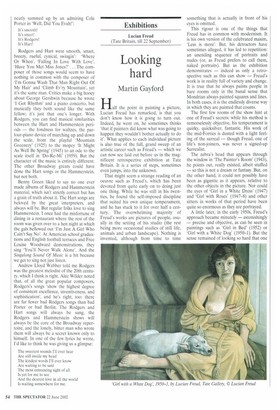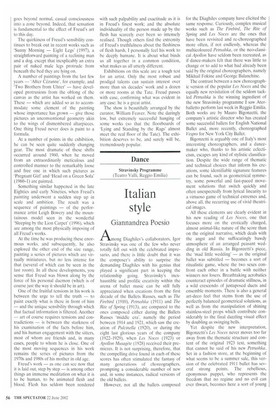Exhibitions
Lucian Freud (Tate Britain, till 22 September)
Looking hard
Martin Gayford
Half the point in painting a picture, Lucian Freud has remarked, is that you don't know how it is going to turn out. Indeed, he went on, he sometimes thinks 'that if painters did know what was going to happen they wouldn't bother actually to do it'. What applies to each individual picture is also true of the full, grand sweep of an artistic career such as Freud's — which we can now see laid out before us in the magnificent retrospective exhibition at Tate Britain. It is a series of steps, sometimes even jumps, into the unknown.
That might seem a strange reading of an oeuvre such as Freud's, which has been devoted from quite early on to doing just one thing. While he was still in his twenties, he found the self-imposed discipline that suited his own unique temperament, and he has stuck to it for over half a century. The overwhelming majority of Freud's works are pictures of people, usually in the setting of his studio (the rest being more occasional studies of still life, animals and urban landscape). Nothing is invented, although from time to time something that is actually in front of his eyes is omitted.
This rigour is one of the things that Freud has in common with modernism. It is his own version of the celebrated maxim, 'Less is more'. But, his detractors have sometimes alleged, it has led to repetition: an unending sequence of portraits and nudes (or, as Freud prefers to call them, naked portraits). But as the exhibition demonstrates — indeed as only a retrospective such as this can show — Freud's work is in reality full of variety and change. It is true that he always paints people in bare rooms only in the banal sense that Mondrian always painted squares and lines. In both cases, it is the endlessly diverse way in which they are painted that counts.
The first few rooms of the show hint at one of Freud's secrets: while his method is remorselessly objective, his temperament is quirky, quicksilver, fantastic. His work of the mid-Forties is dusted with a light feeling of the surreal — though Freud, one of life's non-joiners, was never a signed-up Surrealist.
The zebra's head that appears through the window in 'The Painter's Room' (1943), he points out, really existed, albeit stuffed — so this is not a dream or fantasy. But, on the other hand, it could not possibly have been as gigantic as it appears, relative to the other objects in the picture. Nor could the eyes of 'Girl in a White Dress' (1947) and 'Girl with Roses' (1947-8) and other sitters in works of that period have been quite so enormous as they are portrayed.
A little later, in the early 1950s, Freud's approach became minutely — astonishingly — precise and objective, as can be seen in paintings such as 'Girl in Bed' (1952) or 'Girl with a White Dog' (1950-1). But the sense remained of looking so hard that one goes beyond normal, casual consciousness into a zone beyond. Indeed, that sensation is fundamental to the effect of Freud's art to this day.
The quirkiness of Freud's sensibility continues to break out in recent works such as 'Sunny Morning — Eight Legs' (1997), a straightforward painting of a reclining man and a dog, except that inexplicably an extra pair of naked male legs protrude from beneath the bed they are lying on.
A number of paintings from the last few years 'After Cezanne', for example, and 'Two Brothers from Ulster' — have developed protrusions from the oblong of the canvas as the artist has worked on them. These — which are added so as to accommodate some element of the painting whose importance has grown — give those pictures an unconventional geometry akin to the wings of dismembered altarpieces. One thing Freud never does is paint to a formula.
At a number of points in the exhibition, he can be seen quite suddenly changing gear. The most dramatic of these shifts occurred around 1960, when he moved from an extraordinarily meticulous and controlled manner to the remarkably loose and free one in which such pictures as 'Pregnant Girl' and 'Head on a Green Sofa' (1960-1) are painted.
Something similar happened in the late Eighties and early Nineties, when Freud's painting underwent a sudden step up in scale and ambition. The result was a sequence of paintings — of the performance artist Leigh Bowery and the mountainous model seen in the wonderful 'Sleeping by the Lion Carpet' (1996), which are among the most physically imposing of all Freud's works.
At the time he was producing these enormous works, and subsequently, he also explored the other end of the size range, painting a series of pictures which are virtually miniatures, but no less intense for that (several of which can be seen in the last room). In all these developments, you sense that Freud was blown along by the force of his personal daemon (which is of course just the way it should be in art).
One of the fruitful tensions in his work is between the urge to tell the truth — to paint exactly what is there in front of him — and the unique sensibility through which that factual information is filtered. Another — art of course requires tensions and contradictions — is between the starkness of his examination of the facts before him, and his human engagement with the sitters, most of whom are friends and, in many cases, people to whom he is close. One of the most moving sequences in his work remains the series of pictures from the 1970s and 1980s of his mother in old age.
Freud's work — as one can see now that it is laid out, step by step — is among other things an immense meditation on what it is to be human, to be animated flesh and blood. Flesh has seldom been rendered with such palpability and exactitude as it is in Freud's finest work; and the absolute individuality of the person made up by the flesh has scarcely ever been so intensely realised. Though others find the extremity of Freud's truthfulness about the fleshiness of flesh harsh, I personally feel his work to be deeply humane. It is about what binds us all together in a common condition, what makes us all utterly different.
Exhibitions on this scale are a tough test for an artist. Only the most robust and prodigal talents can sustain interest over more than six decades' work and a dozen or more rooms at the Tate. Freud passes with ease, confirming what was evident in any case: he is a great artist.
The show is beautifully arranged by the curator, William Feaver. Note the daringly low, but extremely successful hanging of some works (so that the floorboards of 'Lying and Standing by the Rags' almost meet the real floor of the Tate). The exhibition deserves to be, and surely will be, tremendously popular.











































































 Previous page
Previous page